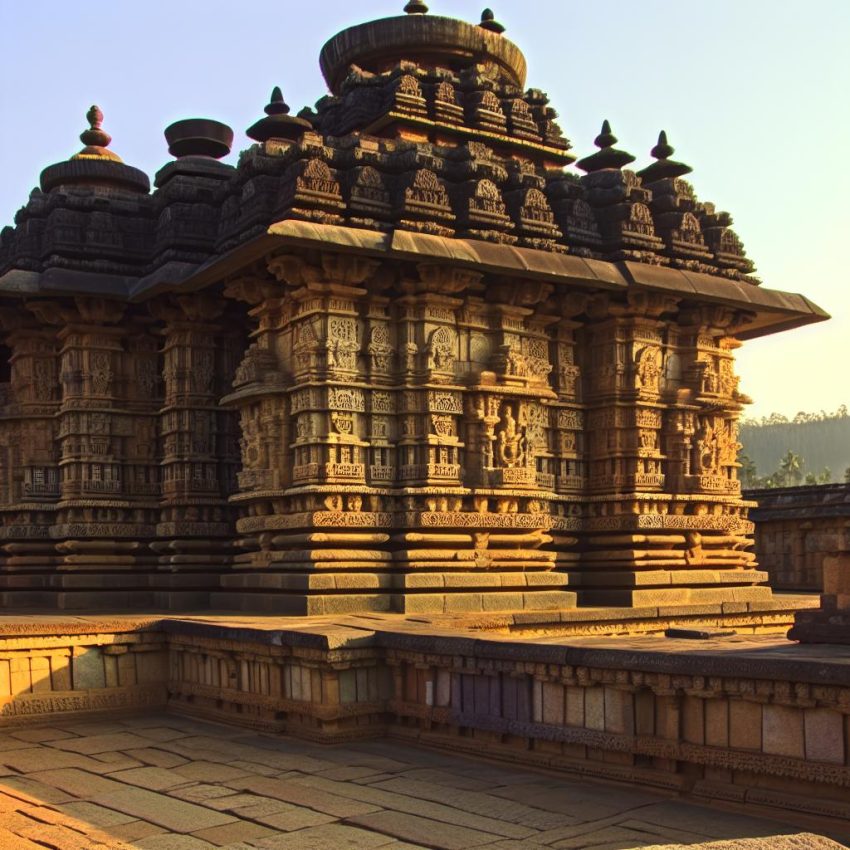Overview of Halebidu Hoysaleswara Temple
The Hoysaleswara Temple, positioned in the town of Halebidu in Karnataka, is an iconic representation of Hoysala architecture and a notable historical landmark from the 12th century. It was built under the auspices of King Vishnuvardhana and is sanctified to Lord Shiva, one of the principal deities in Hindu theology. The temple stands out for its detailed carvings and comprehensive sculptures, serving as a brilliant exemplar of the artistic talents that flourished during the Hoysala period.
Architectural Features
The temple’s architecture is a prime example of the distinct characteristics that define Hoysala era structures. It is renowned for its star-shaped platform, a hallmark of Hoysala design that adds to the overall visual allure of the temple. This particular design contributes not only to the aesthetic value but also to the structural balance and symmetry.
The walls of the temple are replete with a profusion of sculptures. These sculptures depict various deities from the Hindu pantheon, episodes from celebrated Hindu myths, and scenes from everyday life that offer a glimpse into the social and cultural milieus of the time. The outer walls are adorned with friezes that vividly illustrate the life of Lord Shiva in addition to other mythological tales. The precision and detail manifested in these carvings speak volumes about the skill and dedication of the artisans whose work has stood the test of time.
Shrines and Sculptures
The Halebidu Hoysaleswara Temple is distinguished by its dual sanctuaries dedicated to two manifestations of Lord Shiva — Hoysaleswara and Shantaleswara. Within each sanctuary resides a Linga, which stands as the focal point of spiritual focus and veneration. The temple complex also includes a pavilion for Nandi, the bull, which is intricately carved and placed in direct orientation to the sanctuaries. This careful alignment is symbolic and a common feature in Shiva temples, underscoring the sanctity and protective role of Nandi as a guardian.
A closer examination of the temple’s sculptures reveals a rich iconography that spans a wide array of Hindu deities including Vishnu, Narasimha, Ganesha, and Parvati. Each sculpture is not just an artistic endeavor but also a narrative capturing divine legends and philosophies. The temple’s interior is further accentuated by fine filigree work and elaborately carved lattice screens, each contributing to its aesthetic and spiritual dimensions.
Historical Significance
Beyond its architectural grandeur, the Hoysaleswara Temple holds immense historical importance as it encapsulates the power and influence of the Hoysala Empire, which held sway over the southern region of India from the 10th to the 14th century. The temple is a manifestation of the empire’s deep engagement with both art and spirituality. It highlights their commitment to creating enduring cultural monuments that encapsulated their theological beliefs and artistic acumen.
As a historical monument, the temple is invaluable to historians and archaeologists focusing on South Indian history. It offers critical insights into the Hoysala period, their socio-religious practices, and their political dynamics. Through the lens of its sculptures and architecture, one can trace the epoch’s advancements in art, culture, and technology, making it a focal point for academic inquiry and historical interest.
Visiting Information
Today, the Hoysaleswara Temple is a renowned tourist destination, drawing people globally who seek to experience its architectural splendor firsthand. It is maintained by the Archaeological Survey of India, which ensures the preservation of its artistic and historical integrity. The temple is also part of the UNESCO World Heritage tentative list dedicated to recognizing Hoysala architecture’s significance.
Those visiting the temple can embark on a journey through ancient history and art. By exploring the temple complex, visitors can engage with a rich tapestry of cultural narratives and architectural innovations pioneered by the Hoysala dynasty. The temple grounds present an opportunity to reflect on the past, observe the intricacies of ancient craftsmanship, and gain a deeper appreciation of India’s extensive architectural heritage.
In essence, the Halebidu Hoysaleswara Temple continues to stand as a beacon of the Hoysala Empire’s masterful craftsmanship and religious devotion. Its elaborate designs and historical relevance elevate it as a significant site for anyone interested in exploring the depths of India’s architectural and historical legacy. The temple showcases a period where art, religion, and culture were intricately interwoven to produce monuments of enduring beauty and significance.
